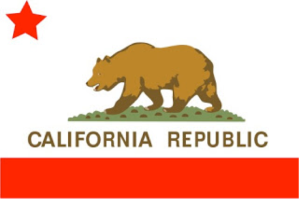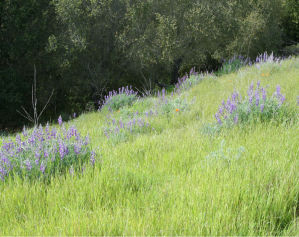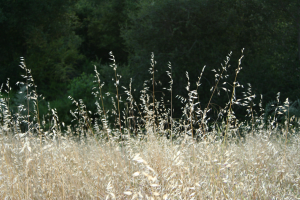William Brewer’s first view of Santa Barbara in 1861 was from the back of a mule. Brewer was part of the California State Geological Survey responsible for conducting a geological and topographic survey of the state, with an eye on identifying mineral resources.

With gold fever having subsided, the new state legislature wanted to have a systematic survey of state’s resources. The well-known geologist, Josiah Whitney, headed the survey. William Brewer’s title was that of “Principle Assistant, in charge of the Botanical Department.” He was responsible for the fieldwork and for keeping detailed records of what was collected, measured, and observed.
With indefatigable energies, an insatiable curiosity, Brewer keep not only the field notes but managed a voluminous correspondence which became the basis for his journal: “Up and Down California in 1860 – 1864,” edited by Francis P. Farquhar and published by the Yale University Press in 1930. My copy, a beautiful edition generously illustrated, was inscribed to my father by Mr. Farquhar. Mr. Farquhar at the time was the editor of the Sierra Club Bulletin and himself a mountaineer and author.
William Brewer and his party departed from Boston, not on a sailing ship, but on a streamer bound for Panama. They crossed the isthmus by train to board another steamer for San Francisco. Like those before him and those after, he was overwhelmed by the beauty of the Bay and impressed by the substantial look of the young city. Brewer compared the early November day, to the finest Indian summer day on the east coast, “but without the smoke.“
From San Francisco, the party steamed south to San Pedro near Los Angeles. After leaving Los Angeles, they travelled north, exploring the coastal terrain, arriving at Santa Barbara region the end of February.
East of Santa Barbara, Brewer climbed a high ridge alone. He discovered a variety of shells weathered out of the rocks “as thick as any seabeach and in good preservation.”
I cannot describe my feelings on that ridge, that shore of an ancient ocean. How lonely and desolate! How many decades of centuries, have elapsed since these rocks resounded to the roar of breakers, and these animals sported in their foam … no human being was within miles of me to break the silence. And then I felt overwhelmed with the magnitude of the work ahead of me … doing field work in this great state, a territory larger than New England and New York, complicated in its geography.
They arrived at the town of Santa Barbara on March 7. The steamer was to leave that night for San Francisco. With only two steamers a month, Brewer comments on Santa Barbara’s isolation where only horse trails connected the community to other settlements to the north. The first, rough wagon road north would be completed later in the spring.
Brewer’s observances about the “decadent town” were much like Dana’s thirty years earlier.
The mission was founded about the time of the American Revolution – the locality was beautiful, water good and abundant. A fine church and ecclesiastical buildings and a town sprung up around. The slope beneath was all irrigated and under high cultivation – vineyards, gardens, fields, fountains once embellished that lovely slope. Now all is changed. The church is in good preservation, with a monastery along side – all else is ruined.
The first two weeks camping near Santa Barbara were most unpleasant (Brewer uses the word “abominable.”) The dense, wet fog meant tramping through wet bushes and thoroughly soaked their campsite.
Brewer describes riding along the beach with two locals, where they observed that asphaltum, a kind of coal-tar which oozes out of the rocks and hardens in the sun. “It occurs in immense quantities and will eventually be a source of some considerable wealth.” (But it was oil itself underlying the Channel that would be the source of wealth in the next century.)
 Once the sun came out again, several of the party rode to the hot springs five miles east and took a refreshing bath in the hot waters, on the way passing “the most remarkable grapevine I have ever seen.”
Once the sun came out again, several of the party rode to the hot springs five miles east and took a refreshing bath in the hot waters, on the way passing “the most remarkable grapevine I have ever seen.”
With the return of the sun, Brewer and a companion set out carrying their barometer in its heavy box, climbing the rocky slopes to the highest ridge where the barometer would register the elevation.
Reaching the first peak, we struck back over a transverse ridge, down and up, through dense chaparral, in which we toiled for seven hours. This is vastly more fatiguing than merely climbing steep slopes: it tries every muscle in the body. We reached the summit at an altitude of 3,800 feet above the sea . . . . . I never before suffered from thirst as I did that day. The moon was bright as we struck down the wild, dangerous trail. Occasionally a snatch of song would awaken the echoes above the clattering of hoofs of the mules over rocks.
Before leaving Santa Barbara, they joined in the celebration of Easter. The festivities of Holy Week, proved more irksome than pleasurable for Brewer as he had to extricate some of his men who had been jailed for brawling and drinking.
The survey continued its work traversing the state in all directions before returning to Boston in late December 1864.
During his almost four years in California, Brewer experienced back-to-back the wettest and driest years on record. During the winter of 1863, The Central Valley was under water. Crops were destroyed and cattle drowned.
 The following year was desperately dry. On May 27, 1864 he writes:
The following year was desperately dry. On May 27, 1864 he writes:
We came on up the San Jose Valley, twenty-one miles. The day was intensely hot, 97 degrees, the air scorching and dusty. The drought is terrible. In this fertile valley there will not be over a quarter crop, and during the past four days’ ride we have seen dead cattle by the hundreds. The hot air trembled over the plain, and occasionally a mirage seemed to promise cool weather, only to vanish as we approached.
William Brewer returned to the East Coast and a successful academic career at Yale. He married again and fathered several children after losing his first wife and newborn son, shortly before departing for California.
Though the survey was a disappointment to some as it is doubtful that the results led to immediate economic gain, much was learned about the mining regions. According to Francis Farquhar in the introduction to the book, “ … great progress was made toward the understanding of the geological history of the country.”
Grasslands
No other plant community speaks more poignantly of the California seasons than the grasslands – emerald green in the winter and early spring and tawny gold in the summer and fall. And in the undulating, rippling sea of grass you see the wind’s signature. Once, a quarter of the state was covered by grassland. But what I celebrate today is profoundly different from the grasslands before the arrival of the Europeans in the late 18th century.
The native perennial grasses have been mostly replaced by the imported European annuals, like the wild oats, whose seeds were often embedded in the fur of the long-horned cattle brought by the first Spaniards and Mexicans. The predominately native perennial grasses were not adapted to the heavy grazing pressure. As the native perennials declined the European annuals moved in. Grasslands, more than any other plant community, were affected by the arrival of the newcomers
The Bear Flag, the flag of the brief-lived republic before California became a state, shows the long-gone grizzly and the native perennial grasses which grew well spaced from one another. Spring wildflowers put on their annual display in these open spaces.
By the time William Brewer and the survey arrived in California the grasslands had been irrevocably altered.
Those interested in restoration have reintroduced bunch grasses in certain areas finding that redoing is slower business than the original undoing.
* * *
 As a child, I reveled in grasslands. In the spring I rolled in the grass, staining my clothes green. I loved the pliant blades, and how green grasses held a trace of moisture even on dry days. I was soothed by the grassland simplicity, not yet understanding its complexity, seeing only an undifferentiated sea of blades. I liked that grasses accentuated the curve of the hills rather than hiding the contours under a coarser cover.
As a child, I reveled in grasslands. In the spring I rolled in the grass, staining my clothes green. I loved the pliant blades, and how green grasses held a trace of moisture even on dry days. I was soothed by the grassland simplicity, not yet understanding its complexity, seeing only an undifferentiated sea of blades. I liked that grasses accentuated the curve of the hills rather than hiding the contours under a coarser cover.
In the summer-dry grass, I would search for singing crickets, but they always stopped singing with my approach. The wind hissed in the dry stalks and picked up the seed-bearing fluff of dandelions carrying it off to new places. Dry grass, even though now lifeless, smelled sweet, like remembered barns full of hay.
Before dying back, grasses had cast out their seeds, which lay dormant, until the first rains in the fall coaxed open the hard seed liberating the first tiny blades of new grass. During the rainy months of winter, the lengthening grass spread over the hills like a green tide.
Your best yet… superb, interesting, factual, and lyrical. Such wonderful descriptions.
Dear Phila,
Your quotations from Brewer’s wonderful account of 1860’s California are well-chosen. I looked in my
copy to find the beautiful passage about “that shore of an ancient ocean,” and I had bracketed that paragraph myself when I read the book in 1978. As an amateur botanist myself, I have come across many plants bearing Brewer’s name. Mountain Heather, described by Brewer himself from Mount Hoffmann in
Yosemite, is called Phyllodoce breweri. Brewer and Hoffmann did most of the mountain ascents and
observation of plants while Whitney was in Sacramento trying to get more funds.
I went to the Southern California Botanists annual symposium in Claremont in November, and one of the
talks was about California grasslands. The new thinking, which is based on accounts by Spaniards
before the Gold Rush and the Missions, is that the extend of perennial grasslands has been greatly
exaggerated. Richard Minnich, a professor at U.C. Riverside, has written a book on the subject.
“His groundbreaking book challenges much current thinking on the subject (of grasslands), critically
evaluating the hypothesis that perennial bunch grasses were once a dominant feature of California’s landscape and instead arguing that wildflowers filled this role.” The state was end-to-end wildflowers.
Minnich’s lecture (and this may also be the title of his book) was called “California’s Fading Wildflowers.”
The tone of the conference was often sad, since so much has been either lost entirely or overwhelmed by invasive species, but no one is in a mood to give up on restoration or to abandon hope. The state has seen
better days, but we have what we have. Thank you for sharing your observations.
Cathy
Dear Phila, Once again you’ve enriched my knowledge of California with your engaging essay. Thank you. Steve and I look forward to seeing you on Sunday, December 28, and learning more from your research and life in Santa Barbara. Are we still okay for staying in the guest quarters that Sunday night? We will call you Sunday morning to plan the day. What is the best phone number to call you?
Wishing you a jolly holiday season. Fondly, Lynn
Sent from my iPad
>
WHAT A WONDERFUL WAY TO BE “RETIRED”, TEACHING US CALIFORNIA HISTORY.
THANK YOU,GEORGE
A marvelous way to end another day in California! Such engaging stories not only about California but also about your youth!
Such enjoyable reading. I would like to know something about your father. He must have been a very interesting man, and left a legacy for you! Faye
I enjoyed reading this. It is hard to imagine the nascent Santa Barbara. You made the area come alive.